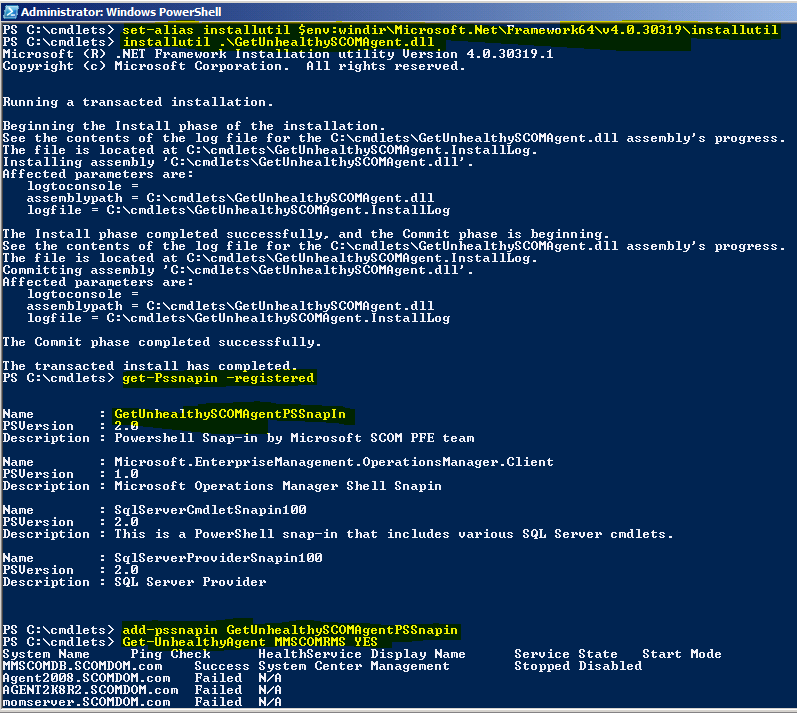PowerShell cmdlet Get Unhealthy Agents in SCOM
In customer environments where resources are strained and
agent health may have degraded over time this PowerShell cmdlet could help
identify the agents in your environment that are currently not functioning.
This sample cmdlet can verify if unavailable agents are responding to ping and
also remotely check if the HealthService is installed, running and whether it
is disabled or set to automatic startup. It also remotely gets the last five or
six event log errors from the OpsMgr Event log to help with diagnosing agent
issues.
Cmdlet gets all agents that are reporting to the specified
Management Group (RMS Server) and returns systems that are “Unavailable” and
not in maintenance mode. A System in maintenance mode returns unavailable as it
is not currently monitoring, so we exclude those systems from the list
returned.
This sample cmdlet takes two parameters:
- First parameter is the RMS Server name, example
MyRMSServer - Second parameter is YES or NO, where YES will
perform the remote checking via ping and WMI query to get the state of the
HealthService. NO will only return the system names
Below are the instructions on how to install this sample
cmdlet on Windows Server 2008 R2 64 bit.
I ran this in a test environment and it does not have to run
on a RMS or MS to work. It must meet the below requirements in order to run
successfully:
- .NET 4.0 Framework
- PowerShell
- SCOM R2 Console (User Interface installed)
- Run as account that has administrative rights to
the SCOM Management Group - When using “YES” for second parameter: Run as
account that has admin rights to systems remotely checking HealthService state
OR will not return data for HealthService state
Download the ZIP file that contains PowerShell cmdlet dll
file and xml help file (GetUnhealthySCOMAgent.dll and UnhealthyAgentCheck.dll-Help.xml)
and save to c:\cmdlets
PowerShell can read from Powershell.exe.config file that adjusts settings PowerShell uses. If the
Powershell.exe.config file does not exist in C:\WINDOWS\system32\WindowsPowerShell\v1.0
then create a Powershell.exe.config file in that directory. If the file exists
verify that it is similar to below if required add supportedRuntime v4 line to
ensure the cmdlet built on v4 of .NET will work.
Copy the contents below into the config file and save:
<?xml version="1.0"?>
<configuration>
<startup
useLegacyV2RuntimeActivationPolicy="true">
<supportedRuntime version="v4.0.30319"/>
<supportedRuntime version="v2.0.50727"/>
</startup>
</configuration>
Open PowerShell and Run as administrator.
Run commands below:
set-alias installutil $env:windir\Microsoft.Net\Framework64\v4.0.30319\installutil
cd c:\cmdlets
installutil .\GetUnhealthySCOMAgent.dll
get-Pssnapin -registered
Verify the cmdlet is displayed in the registered list by running below command
add-pssnapin GetUnhealthySCOMAgentPSSnapin
Get-UnhealthyAgent MMSCOMRMS NO
It is likely that your list is larger than mine, so you may want to pipe results to some file and then copy the contents to excel. Strings
are tab delimited so it will format nicely with a paste into Excel.
Get-UnhealthyAgent MMSCOMRMS YES | out-file
c:\cmdlets\output.txt
Then you can open the file and copy and paste to Excel.
NOTE: This is the command line to use if you want to uninstall the cmdlet:
installutil /u .\GetUnhealthySCOMAgent.dll
Cmdlets can help automate many tasks to reduce workload and improve your environments health. Let me know what you think.
Disclaimer:
This example is provided “AS IS” with no warranty expressed
or implied. Run at your own risk.
The opinions and views expressed in this
blog are those of the author and do not necessarily state or reflect those of
Microsoft.

